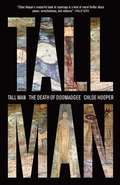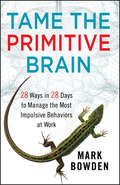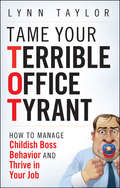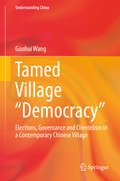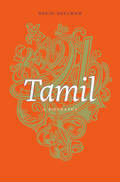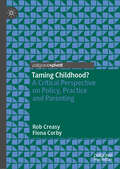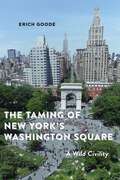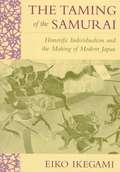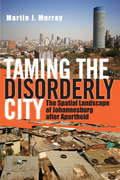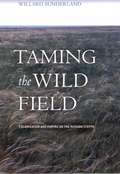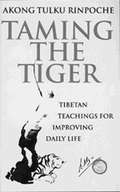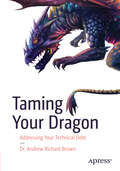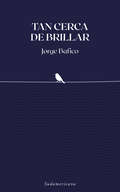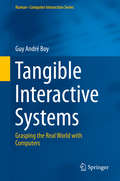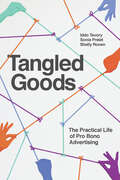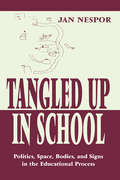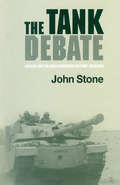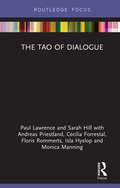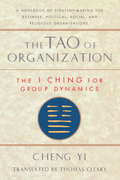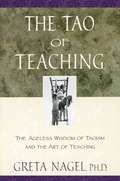- Table View
- List View
Tall Man
by Chloe HooperEarly in 2005 Chloe Hooper was drawn into the bewildering and tragic case of Cameron Doomagee, an Aboriginal man on Australia's Palm Island, who died in police custody within one hour of his arrest. Like Joan Didion and Norman Mailer, Hooper brings a novelist's eye for detail and an acute understanding of character to this story. She explores the daily lives of these people, the role of the mythology and superstition, the impact of landscape, and the history of devastating repression, addiction and violence among the Aboriginal people. Hooper is brought to Palm Island by the lawyer representing Doomagee. She spends months garnering the trust of all involved. She recreates both the dramatic events of one morning and all the forces, "individual and historic" that led up to it. And then she chronicles the trial of the charismatic police Sergeant charged with manslaughter, "the first police office in Australia ever to be charged over a death in custody. This is an outstanding account of a landmark episode in Australian history, a searing story of racial conflict that will resonate with American readers.
Tame the Primitive Brain
by Mark BowdenA new and simple system to understanding and controlling the behavior of othersNoted body language, behavior and communication expert Mark Bowden offers a totally practical, easy-to-read guide to understanding the impulsive actions of others, along with the best tools to manage them. A number one anxiety in business is dealing with problem people. In Tame the Primitive Brain, Mark Bowden's fresh approach is the fastest and most effective way to understand why someone acts towards you the way they do; why you react to their behavior in the way you do; and most importantly, what exactly to do about it to achieve the right outcomes.Brings new and fresh perspectives to business readers for dealing with tricky behaviorsExplains how to effectively manage those around you at any level in an organization Shares the latest evolutionary behavioral theory, neuroscientific evidence, and the tried and tested tools and tricks based on these premisesThis simple model of how we humans can and do relate to each other brings increased depth of understanding and expands your toolset to better manage yourself and others to achieve anything.
Tame Your Terrible Office Tyrant
by Lynn TaylorAn indispensable guide to dealing with challenging, childish boss behavior and building a great career, with laugh- out-loud humor built in. Based on extensive interviews among workers, managers and psychologists, Tame Your Terrible Office Tyrant™ draws hilarious but true parallels between toddlers and managers. When under stress, both often have trouble moderating their power, or lose the ability to think rationally. Traits in common include tantrum-throwing, demanding, stubborn, moody, fickle, self-centered, needy and whiny behavior. BADD (Boss Attention Deficit Disorder) is discussed as part of "Short Attention Spans. " There are 20 chapter traits in all, divided into "Bratty" and "Little Lost Lamb" categories, for easy reference, including real anecdotes and many useful tips. When bad bosses run amok in companies, nobody wins. This book shows readers how to build positive relationships with even the most out-of-control boss, and still thrive in your job. The key to success lies in dealing with a Terrible Office Tyrant (or TOT™) much like a parent deals with a troublesome toddler. With true stories and time-tested solutions, this is the perfect guide managing a boss stuck in his Terrible Twos. Taylor takes you behind all the bossy blustering, so that you can focus on getting ahead - and achieve career excellence. Savvy top management will also gain insight on what not to do with their team. They know that Terrible Office Tyrant (TOT) managers may not be in plain sight (they don't leave juice stains on the hallway carpet!) But they do wreak havoc on the bottom line. A special section helps senior management and Human Resource departments mitigate TOT behavior for a more productive workplace.
Tamed Village "Democracy"
by Guohui WangWang's book offers an empirically rich and conceptually nuanced analysis of how local state agents maintain control over village self-governance in China. His careful analysis of primary documents enables him to explicate the formal mechanisms used by members of the local state to influence village affairs. Meanwhile, his rigorous and fascinating ethnographic data enable him to elucidate the manifold ways in which informal clientelist ties between local state officials and village elites permit the former to exert control. Overall, this excellent book powerfully demonstrates the need for scholars to go beyond attention to election processes when evaluating what village democracy means in a Chinese context. It is a must-read for all serious scholars of Chinese politics and society. --Rachel Murphy, University of Oxford Guohui Wang's highly original, in-depth case research vividly reveals the dynamics of contemporary Chinese village politics. By combining abundant empirical data with close observation as an "insider," his book illustrates the processes and consequences of transplanting 'democracy' into rural Chinese society. Particularly for those in the West who are keen on understanding the ongoing transformation of rural China, this book is a rich and revealing source. --Shukai Zhao, Development Research Center of the State Council, P. R. China
Tamil: A Biography (Princeton Legacy Library #597)
by David ShulmanSpoken by eighty million people, Tamil is one of the great world languages, and one of the few ancient languages that survives as a mother tongue. David Shulman presents a comprehensive cultural history of Tamil, emphasizing how its speakers and poets have understood the unique features of their language over its long history.
Taming Childhood?: A Critical Perspective on Policy, Practice and Parenting
by Rob Creasy Fiona CorbyThis book explores the links between recent reports of increasing levels of unhappiness and mental health problems amongst children and young people, and changes within childhood which restrict and reduce opportunities for children to develop and maintain resilience. Although in academic terms children may be viewed as beings, Creasy and Corby posit that there is much to suggest that for parents, practitioners and policy-makers, children are primarily seen as becomings. The book argues that viewing children as becomings, together with the idea that childhood is fraught with danger, contributes to practices and policies which can be seen as making childhood tame. This taming of childhood leads to an impoverished childhood that does not provide the space that children need to grow and develop. Furthermore, Taming Childhood? challenges the idea that young adults are 'snowflakes', unable to cope with everyday pressures. Students and scholars across a range of social science disciplines will find this book of interest.
The Taming of New York's Washington Square: A Wild Civility
by Erich GoodeThe surprising and unofficial system of social control and regulation that keeps crime rates low in New York City’s Washington Square Park Located in New York City’s Greenwich Village, Washington Square Park is a 9.75-acre public park that is perhaps best known for its historic Washington Square Arch, a landmark at the foot of 5th Avenue. Hundreds, if not thousands, pass through the park every day, some sit on benches enjoying the sunshine, play a game of chess, watch their children play in the playground, take their dog to the dog runs, or sit by the fountain or, sometimes, buy or sell drugs. The park has an extremely low crime rate. Sociologist, and local resident, Erich Goode wants to know why. He notes that many visitors do violate park rules and ordinances, even engaging in misdemeanors like cigarette and marijuana smoking, alcohol consumption, public urination, skateboarding and bike riding. And yet, he argues, contrary to the well-known “broken windows” theory, which suggests that small crimes left unchecked lead to major crimes, serious crimes hardly ever take place there. Why with such an immense volume of infractions—and people—are there so little felonious or serious, and virtually no violent, crime? With rich and detailed observations as well as in-depth interviews, Goode demonstrates how onlookers, bystanders, and witnesses—both denizens and your average casual park visitor—provide an effective system of social control, keeping more serious wrongdoing in check. Goode also profiles the parks visitors, showing us that the park is a major draw to residents and tourists alike. Visitors come from all over; only a quarter of the park’s visitors live in the neighborhood (the Village and SoHo), one out of ten are tourists, and one out of six are from upper Manhattan or the Bronx. Goode looks at the patterns of who visits the park, when they come, and, once in the park, where they go. Regardless of where they live, Goode argues, all of the Park’s visitors help keep the park safe and lively. The Taming of New York’s Washington Square is an engaging and entertaining look at a surprisingly safe space in the heart of Manhattan.
The Taming Of The Samurai: Honorific Individualism And The Making Of Modern Japan
by Eiko IkegamiModern Japan offers us a view of a highly developed society with its own internal logic. Eiko Ikegami makes this logic accessible to us through a sweeping investigation into the roots of Japanese organizational structures. She accomplishes this by focusing on the diverse roles that the samurai have played in Japanese history. From their rise in ancient Japan, through their dominance as warrior lords in the medieval period, and their subsequent transformation to quasi-bureaucrats at the beginning of the Tokugawa era, the samurai held center stage in Japan until their abolishment after the opening up of Japan in the mid-nineteenth century. This book demonstrates how Japan's so-called harmonious collective culture is paradoxically connected with a history of conflict. Ikegami contends that contemporary Japanese culture is based upon two remarkably complementary ingredients, honorable competition and honorable collaboration. The historical roots of this situation can be found in the process of state formation, along very different lines from that seen in Europe at around the same time. The solution that emerged out of the turbulent beginnings of the Tokugawa state was a transformation of the samurai into a hereditary class of vassal-bureaucrats, a solution that would have many unexpected ramifications for subsequent centuries. Ikegami's approach, while sociological, draws on anthropological and historical methods to provide an answer to the question of how the Japanese managed to achieve modernity without traveling the route taken by Western countries. The result is a work of enormous depth and sensitivity that will facilitate a better understanding of, and appreciation for, Japanese society.
Taming the Corpus: From Inflection and Lexis to Interpretation (Quantitative Methods in the Humanities and Social Sciences)
by Masako Fidler Václav CvrčekThis book bridges the current quantitative and qualitative text analyses, using grammar as a crucial source of investigation. Taking data from Czech, an inflected language, in which the most optimal conditions to respond to this research question are met, the book expands the understanding of language and text in ways that have not been executed before. For predominantly English-based quantitative research, this volume fills a crucial gap by examining the relationship between inflection and other phenomena (including discourse, translation and literature). For the current qualitative research, the volume provides large empirical data to confirm some of its claims, but more importantly, it demonstrates the important role of detailed grammatical concepts that have not been considered before. Besides addressing fundamental questions about text analysis methods, the volume presents a diverse array of Czech data that are unique in their own right and worthy of dissemination to the general audience. Taming the Corpus: From Inflection and Lexis to Interpretation is divided into three sections. Section 1 deals with phonotactics, poetic structure, morphological complexity used to differentiate literary style, and native speakers’ sense of grammaticality – issues pertinent to linguistic typology, cognition and language, and literary studies. Section 2 focuses on inter-language relations, especially the theory of translation. Section 3 demonstrates how quantitative analysis of texts can contribute to our understanding of society and connects the volume to legal language, construction of gender and discourse position and implicit ideology.
Taming the Disorderly City: The Spatial Landscape of Johannesburg after Apartheid
by Martin J. MurrayIn postapartheid Johannesburg, tensions of race and class manifest themselves starkly in struggles over "rights to the city." Real-estate developers and the very poor fight for control of space as the municipal administration steps aside, almost powerless to shape the direction of change. Having ceded control of development to the private sector, the Johannesburg city government has all but abandoned residential planning to the unpredictability of market forces. This failure to plan for the civic good—and the resulting confusion—is a perfect example of the entrepreneurial approaches to urban governance that are sweeping much of the Global South as well as the cities of the North.Martin J. Murray brings together a wide range of urban theory and local knowledge to draw a nuanced portrait of contemporary Johannesburg. In Taming the Disorderly City, he provides a focused intellectual and political critique of the often-ambivalent urban dynamics that have emerged after the end of apartheid. Exploring the behaviors of the rich and poor, each empowered in their own way, as they rebuild a new Johannesburg, we see the entrepreneurial city: high-rises, shopping districts, and gated communities surrounded by and intermingled with poverty. In graceful prose, Murray offers a compelling portrait of the everyday lives of the urban poor as seen through the lens of real-estate capitalism and revitalization efforts.
Taming the Elephant: Politics, Government, and Law in Pioneer California
by John F. Burns Richard J. OrsiLively, authoritative essays on the political history of California from the Gold Rush and the achievement of statehood through the end of the 19th century. The fourth and final volume in a series of essays on California history, co-published with the California State Historical Society.
Taming the River: Negotiating the Academic, Financial, and Social Currents in Selective Colleges and Universities (The William G. Bowen Series #51)
by Camille Z. Charles Mary J. Fischer Margarita A. Mooney Douglas S. MasseyBuilding on their important findings in The Source of the River, the authors now probe even more deeply into minority underachievement at the college level. Taming the River examines the academic and social dynamics of different ethnic groups during the first two years of college. Focusing on racial differences in academic performance, the book identifies the causes of students' divergent grades and levels of personal satisfaction with their institutions. Using survey data collected from twenty-eight selective colleges and universities, Taming the River considers all facets of student life, including who students date, what fields they major in, which sports they play, and how they perceive their own social and economic backgrounds. The book explores how black and Latino students experience pressures stemming from campus racial climate and "stereotype threat"--when students underperform because of anxieties tied to existing negative stereotypes. Describing the relationship between grade performance and stereotype threat, the book shows how this link is reinforced by institutional practices of affirmative action. The authors also indicate that when certain variables are controlled, minority students earn the same grades, express the same college satisfaction, and remain in school at the same rates as white students. A powerful look at how educational policies unfold in America's universities, Taming the River sheds light on the social and racial factors influencing student success.
Taming the Wild Field: Colonization and Empire on the Russian Steppe
by Willard SunderlandWillard Sunderland chronicles the colonization of the Russian steppes & discusses how the steppe lands have changed in the Russian imagination over time, from the 'wild field' of the middle ages, to the iconic status of the 19th century, when the vast grasslands had become a symbol of Russian nationhood.
Taming The Tiger: Tibetan Teachings For Improving Daily Life
by Akong Tulku RinpocheTAMING THE TIGER offers a simple approach to finding happiness for oneself that also brings happiness to others. Based on twenty years of Buddhist teaching in the West, Taming the Tiger aims to help anyone seeking the truth about suffering and happiness. The first part of the book deals with topics such as Impermanence, The Right Motivation, Facing the Situation, Body, Speech and Mind, Compassion, and Mindfulness. The second part is devoted to exercises, meditations and relaxation techniques for body and mind, including Feeling, Openness, Taking Suffering, Bringing the Buddha to Life and Universal Compassion. The exercises, designed to provide a base of self-knowledge, mind-therapy and self-healing have also been found beneficial in therapy workshops and in the treatment of psychological problems.This practical programme has been tested and refined first at therapy workshops of Samye Ling in Scotland - the oldest Tibetan Buddhist centre in the West - and has since confirmed its success in cities throughout Europe, North America and Africa, bringing definitive solutions to long-term problems weighing heavily on the mind.
Taming Your Dragon: Addressing Your Technical Debt
by Dr. Andrew BrownTechnical debt is an often-overlooked problem that the software industry needs to take more seriously. All organizations are impacted by it, most wish that they had less of it, but need help in understanding the nature of the beast. This book aims to clear up any misconceptions and show you how to implement a sound technical debt management program to suit your company’s needs. You’ll learn the greatest challenge in solving the technical debt dilemma is not to find solutions to it, but rather to find solutions to the human and organizational issues that lead to that debt. For example, convincing senior stakeholders of the importance of addressing technical debt, getting stakeholders to acknowledge how their actions lead to unintentional debt, and enabling teams to prioritize technical debt over short-term goals. Therefore, this book is divided into three parts: defining technical debt, understanding technical debt, and tackling technical debt. It begins by explaining why technical debt should not be considered a technical problem, but rather a problem of how trade-off decisions are made. You’ll then examine how making decisions using the affect heuristic, more commonly known as a “gut feeling,” can lead to unnecessary technical debt, followed by some techniques for combating your vulnerability to this trap. Reducing your organization’s level of technical debt is not easy. Taming Your Dragon will show you how to implement a technical debt management program. What You Will Learn Review a new paradigm based on technical debt being a combination of trade-off problems and system problems Understand the many ways that technical debt adversely affects an organization’s ability to deliver IT change Create an effective process for addressing technical debt See why analogies are important Who This Book Is For Software teams supporting DevOps, managers, and other business stakeholders looking to implement a technical debt management program.
Tan cerca de brillar
by Jorge BaficoUn libro intenso y personal. La crónica de la pérdida de un hijo como motivo literario, que habilita y proyecta un recorrido emotivo y sanador a través de los vínculos familiares, la posibilidad de salir del dolor y recuperar la esperanza. Este libro es testigo de una batalla contra el dolor lacerante de una pérdida. Jorge Bafico intenta construir una ficción que se aleje de la angustia vivida, pescando palabras que sirvan para transmutar el sufrimiento y convertirlo en poesía. Estas páginas son parte de un relato dedicado a alguien que no pudo florecer. A través de la mirada compasiva y llena de empatía de su narrador, las personas y las situaciones retratadas iluminan el pasado y el presente, obrando el milagro de convertir el dolor en esperanza.
Tangible Interactive Systems
by Guy André BoyDistinguishingbetween tangible user interfaces (TUI) and tangible interactive systems (TISs),this book takes into account not only the user interfaces but also looks at howinteraction can be enabled by using digital information through the physicalenvironment. TISs go far beyond the concept of tangible user interfaces,addressing large complex systems in the framework of human-centred design andputting the human at the center of the design process from the start. Howcan human-centered designers grasp the real world with computers? This questionis explored by looking at concepts such as innovation, complexity, flexibility,maturity, stability, sustainability and art to see whether we can assess bothphysical and figurative tangibility during the design process before productdelivery. Concepts like creativity, design thinking and team spirit arefundamental to TIS's human-centered design, and are presented together withhuman-systems integration (HSI), agile development and formative evaluations tobuild a greater understanding of this new area of research. TangibleInteractive Systems wouldbe an essential read to designers, academics and other professionals concernedwith product design within HCI, industrial design, virtual engineering andother related areas.
Tangled Goods: The Practical Life of Pro Bono Advertising
by Iddo Tavory Sonia Prelat Shelly RonenA novel investigation of pro bono marketing and the relationship between goods, exploring the complex moral dimensions of philanthropic advertising. The advertising industry may seem like one of the most craven manifestations of capitalism, turning consumption into a virtue. In Tangled Goods, authors Iddo Tavory, Sonia Prelat, and Shelly Ronen consider an important dimension of the advertising industry that appears to depart from the industry’s consumerist foundations: pro bono ad campaigns. Why is an industry known for biting cynicism and cutthroat competition also an industry in which people dedicate time and effort to “doing good”? Interviewing over seventy advertising professionals and managers, the authors trace the complicated meanings of the good in these pro bono projects. Doing something altruistic, they show, often helps employees feel more at ease working for big pharma or corporate banks. Often these projects afford them greater creative leeway than they normally have, as well as the potential for greater recognition. While the authors uncover different motivations behind pro bono work, they are more interested in considering how various notions of the good shift, with different motivations and benefits rising to the surface at different moments. This book sheds new light on how goodness and prestige interact with personal and altruistic motivations to produce value for individuals and institutions and produces a novel theory of the relationship among goods: one of the most fraught questions in sociological theory.
Tangled Goods: The Practical Life of Pro Bono Advertising
by Iddo Tavory Sonia Prelat Shelly RonenA novel investigation of pro bono marketing and the relationship between goods, exploring the complex moral dimensions of philanthropic advertising. The advertising industry may seem like one of the most craven manifestations of capitalism, turning consumption into a virtue. In Tangled Goods, authors Iddo Tavory, Sonia Prelat, and Shelly Ronen consider an important dimension of the advertising industry that appears to depart from the industry’s consumerist foundations: pro bono ad campaigns. Why is an industry known for biting cynicism and cutthroat competition also an industry in which people dedicate time and effort to “doing good”? Interviewing over seventy advertising professionals and managers, the authors trace the complicated meanings of the good in these pro bono projects. Doing something altruistic, they show, often helps employees feel more at ease working for big pharma or corporate banks. Often these projects afford them greater creative leeway than they normally have, as well as the potential for greater recognition. While the authors uncover different motivations behind pro bono work, they are more interested in considering how various notions of the good shift, with different motivations and benefits rising to the surface at different moments. This book sheds new light on how goodness and prestige interact with personal and altruistic motivations to produce value for individuals and institutions and produces a novel theory of the relationship among goods: one of the most fraught questions in sociological theory.
Tangled Goods: The Practical Life of Pro Bono Advertising
by Iddo Tavory Sonia Prelat Shelly RonenA novel investigation of pro bono marketing and the relationship between goods, exploring the complex moral dimensions of philanthropic advertising. The advertising industry may seem like one of the most craven manifestations of capitalism, turning consumption into a virtue. In Tangled Goods, authors Iddo Tavory, Sonia Prelat, and Shelly Ronen consider an important dimension of the advertising industry that appears to depart from the industry’s consumerist foundations: pro bono ad campaigns. Why is an industry known for biting cynicism and cutthroat competition also an industry in which people dedicate time and effort to “doing good”? Interviewing over seventy advertising professionals and managers, the authors trace the complicated meanings of the good in these pro bono projects. Doing something altruistic, they show, often helps employees feel more at ease working for big pharma or corporate banks. Often these projects afford them greater creative leeway than they normally have, as well as the potential for greater recognition. While the authors uncover different motivations behind pro bono work, they are more interested in considering how various notions of the good shift, with different motivations and benefits rising to the surface at different moments. This book sheds new light on how goodness and prestige interact with personal and altruistic motivations to produce value for individuals and institutions and produces a novel theory of the relationship among goods: one of the most fraught questions in sociological theory.
Tangled Up in School: Politics, Space, Bodies, and Signs in the Educational Process (Sociocultural, Political, and Historical Studies in Education)
by Jan NesporBased on two years of ethnographic fieldwork in an urban elementary school, this volume is an examination of how school division politics, regional economic policies, parental concerns, urban development efforts, popular cultures, gender ideologies, racial politics, and university and corporate agendas come together to produce educational effects. Unlike conventional school ethnographies, the focus of this work is less on classrooms than on the webs of social relations that embed schools in neighborhoods, cities, states, and regions. Utilizing a variety of narratives and analytical styles, this volume: * explores how curriculum innovations are simultaneously made possible by and undermined by school district politics, neighborhood histories, and the spatial and temporal organizations of teachers' and parents' lives; * situates the educational discourse of administrators and teachers in the changing economic and political climates of the city; * analyzes the motivations behind an effort by school and business proponents to refashion classrooms within the school into business enterprises, and of children's efforts to make sense of the scheme; * examines the role of the school as a neighborhood institution, situating it at the intersections of city planners' efforts to regulate city space and children's efforts to carve out live spaces through out-of-school routines; * contemplates the meaning of school as a site for bodily experience, and looks at how patterns of space and control in the school shaped children's bodies, and at how they continued to use body-based languages to construct maturity, gender, and race; and * investigates the school as a space for the deployment of symbolic resources where children learned and constructed identities through their engagements with television, comic books, movies, and sports. Tangled Up In School raises questions about how we draw the boundaries of the school, about how schools fit into the lives of children and cities, and about what we mean when we talk about "school."
The Tank Debate: Armour and the Anglo-American Military Tradition
by John StoneIn The Tank Debate, John Stone highlights the equivocal position that armour has traditionally occupied in Anglo-American thought, and explains why - despite frequent predictions to the contrary - the tank has remained an important instrument of war. This book provides a timely and provocative study of the tank's developmental history, against the changing background of Anglo-American military thought.
The Tao of Dialogue (Routledge Focus on Mental Health)
by Paul Lawrence Sarah Hill Andreas Priestland Cecilia Forrestal Floris Rommerts Isla Hyslop Monica ManningContemporary writers position ‘dialogue’ at the heart of change theory, but what do we mean by ‘dialogue’? The Tao of Dialogue explains through story what dialogue means, and how to leverage dialogic principles in managing relationships within the workplace. Accessible and innovative, The Tao of Dialogue explains the basic principles of dialogue, defined as a way of thinking and reflecting together with others, through the story of Michael, the CEO of a company about to embark on a life-changing journey. In the first half of the book, he is introduced to the idea of dialogue by Hannah, an internal change practitioner working within the organisation. He is encouraged to engage in dialogue with those he seeks to influence, which requires him to examine his mindset and proactively make changes to the ways in which he is communicating with his team and the wider organisation. In the second half of the book Michael is assisted by Mark, an external consultant with expertise in dialogic team and organisational development, who helps him apply dialogic principles to leading his team. Engaging yet practical, each part concludes with a summary of the dialogue that has taken place and how the model can be used in the real world, as well as an overview of the journey of the organisation, team and individuals. Emerging from dialogue between seven experienced, international coaches, The Tao of Dialogue will be of interest to coaches in practice and training, as well as business leaders, HR and L&D professionals and consultants. It explains in simple terms how to transform human relationships, both one-to-one and team/group. It will also appeal to academics and students of coaching, executive development, change management and leadership development.
The Tao of Organization: The I Ching for Group Dynamics
by Thomas ClearyOf particular interest for its application to business strategizing, this edition of the well-known ancient Chinese classic I Ching (The Book of Changes) guides readers through the intricacies of group dynamics and relationships within organizations of all kinds. The root text is supported by a commentary from the eleventh-century scholar Cheng Yi, founder of the movement known as Lixue, the "study of inner design." Cheng contended that by understanding the pattern of events--the inner design of nature--one can bring about mutual understanding and cooperation among people in groups, thus facilitating the accomplishment of any tasks they might undertake. The translator's extensive introduction gives specific, systematic guidelines for consulting the I Ching for greatest understanding and best results. Included in the afterword is a profile of the modern and Japanese organizational genius Matsushita Konosuke, founder of Panasonic and other multinational corporations, whose success has been built on the principles of the I Ching.
The Tao of Teaching: The Ageless Wisdom of Taoism and the Art of Teaching
by Greta K. NagelThe Tao of Teaching is for teachers, parents, and any others who are looking for a book of wisdom on how to deal with people, especially children, in a learning environment. The Tao of Teaching is written in the same style as the Tao Te Ching, and gives examples from the classrooms of three present-day teachers whom the author feels embody Taoist wisdom and "student-centered" educational methods. The Tao of Teaching is a labor of love, containing many important insights by a talented and respected professional whose emphasis is on the students' contribution in a learning environment, whatever the context.
